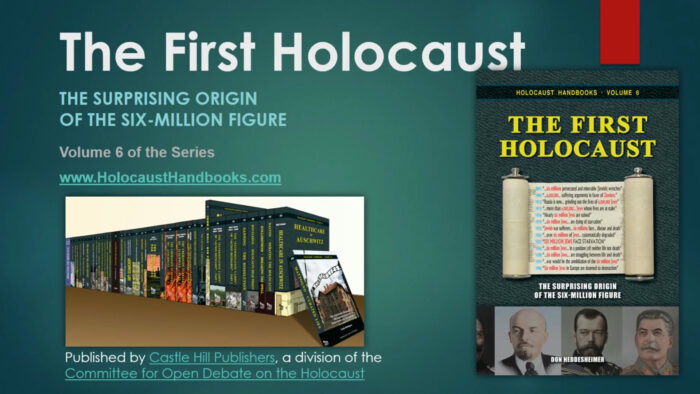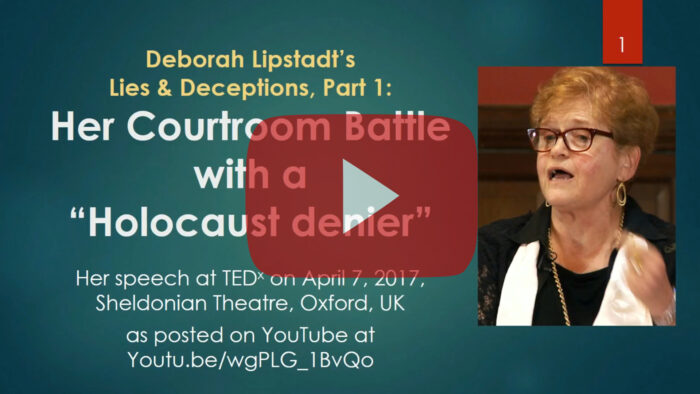Moving with Movies
A picture tells more than a thousand words, and moving pictures tell more than a million words, one might add. The power of movies – both of the fiction and non-fiction genre – to convince the gullible as well as many skeptical minds can hardly be underestimated. This is particularly true in our times of reduced attention spans, and the dominance of the media sphere by TV and video streaming platforms, most of all YouTube.
While Inconvenient History is a forum of words, we are no strangers to pictures. In past years, illustrations in our periodical have been more decorative than explanatory. However, the current issue has several papers that are based on the transcripts of video documentaries, and these very documentaries are an integral part of those papers for our online edition. Accepting such video papers was announced with the editorial of the first issue of this year, and we carried one such paper already in this year’s third issue (see “Germany, Country under the Rule of Law: Role Model or Illusion?”).
The present issue has two more such papers (“The Lies and Deceptions of Deborah Lipstadt” and “Probing the Holocaust”), plus a third paper that is accompanied by a documentary supporting the points made by its author (“The Chemistry of Auschwitz/Birkenau”).
All these documentaries were produced by myself, with one of them (Probing the Holocaust) relying to a large degree on footage used by an earlier version of this documentary created by Eric Hunt (which was titled Questioning the Holocaust: Why We Believed).

Eric Hunt has created several revisionist documentaries over the past several years, among them The Last Days of the Big Lie (2 h 5 min, 2009), The Treblinka Archeology Hoax (1 h 20 min, 2014), The Majdanek Gas Chamber Myth (1 h 22 min, 2014) and last but not least the already-mentioned Questioning the Holocaust (1 h 30 min, 2016). All of them were once featured on CODOH’s website www.HolocaustHandbooks.com, with the last three integrated in our series Holocaust Documentaries. However, if you look for them now, they cannot be found there anymore, and you’d be hard pressed to find copies of them anywhere. (Try locating copies of them on Vimeo, Bitchute or other alternative streaming platforms).
The reason for that censorship are threats by the Eric Hunt to sue anyone who violates his copyright by posting these documentaries publicly without his consent, which he refuses to give to anyone. Eric Hunt had a change of mind in early 2017, suddenly taking a polar-opposite stance in matters Holocaust, and bailing out of creating documentaries on this topic altogether. This is not the place to report the background of Hunt defecting revisionism as I experienced it first-hand. What matters are the repercussions of it.
Eric and I had been working together for several years, with me in a mere advisory role for the latter three documentaries mentioned above. In late 2016, we visited the US Holocaust Memorial Museum in D.C. together, in preparation of a new documentary we wanted to work on together. That project never materialized, however. When Hunt resigned from creating documentaries for Castle Hill in early 2017, all plans to create more such video content fell apart.
After a short while of hesitation, forcibly extended by the fact that Amazon banned all of Castle Hill’s books from their platform in early March of this year (see the editorial to the second issue of this volume of Inconvenient History, starting on page 127), which resulted in Castle Hill losing some 40% of its turnover in book sales, I decided to take a stab at the film-making genre myself. Already in May 2016, I had created a documentary named after and based on Carlo Mattogno’s book Curated Lies, which discusses the lies and deceptions of the Auschwitz Museum, and another video named after and based on Don Heddesheimer’s book The First Holocaust.[1] However, both these documentaries were based on mere PowerPoint presentations. While they are highly animated, they are not really movies, and turning them into video footage was difficult, because Microsoft software is notoriously unreliable when it comes to doing things predictably and accurately as defined. In this case, automated animations with pre-defined timelines never behaved as they were set to behave. It was very challenging to create a smoothly flowing video from the raw footage PowerPoint produces. But I had no other software nor the skills to produce videos otherwise. With Hunt having bailed out, that had to change.

The first project I took on using proper software was turning my first revisionist work – my research on the Chemistry of Auschwitz – into a documentary. A new, revised, updated and expanded edition of this work with exactly that title had gone into print just weeks after Eric had jumped ship. Hence, I set out on a journey to figure out what software is best suited for turning it into a video. The first software suit I used (NCH) turned out to be a horror show. I spent weeks creating the documentary, but when trying to do the final cut, this software randomly inserted blacked-out sequences in unpredictable places. It was useless.
After a few more failed attempts at using other market-leading video-creation programs, I settled for Adobe Premiere Elements. It was affordable, relatively easy to learn, and its results were reliable, predictable, and offered the flexibility I needed.

Creating a video takes much more time than simply writing a paper. In fact, a good documentary script is the ineluctable starting point of any such movie project, and our videos being controversial in nature, they moreover better be well researched and backed up with incontrovertible proof.
When watching my videos, you may notice that they have a feature rarely seen in documentaries: They contain source information, usually displayed as small-font text boxes at the bottom of the screen. You will not find that in any mainstream documentary. They simply assume that you believe whatever they say, without asking for proof. We revisionists, however, should not and cannot operate this way. We have to work under the assumption that most viewers watching our material are skeptical.
While it is true that some of our supporters may trust us intrinsically and may take our claims at face value, this is certainly not the case for people who are not (yet) convinced that we have a point, let alone that we are right. I am not producing video documentaries to show to the choir boys in the revisionist echo chamber. There is no point in going through the huge effort of producing a documentary in order to cater to people who are already convinced. Our videos need to be designed to reach out of our little ostracized and marginalized community, so that we may expand our audience. YouTube is the best platform to achieve this. In order to make sure that skeptics can verify what we claim, I include “footnotes” with source information in all videos. And by the way, it also helps others to find footage we have used and other information we mention, so they can create their own content. (And it helps me find my own sources, if I ever lose track.)
When working with Eric Hunt on past projects, I wanted him to follow that unusual guideline of “sourcing” footage and claims as well. It was so contrary to industry practice that he balked and refused. This issue was one reason for the chasm eventually opening up between us. Now I am stuck with footage he created that I do not know where he got it from, so recreating it and proving that it is legitimate footage is difficult, to say the least.
As long as YouTube allows us to spread the Good News of Holocaust revisionism, we will create more such contents and post it on that platform in order to expand our audience. I say that with caution, because YouTube started in 2016 to block our contents in European countries, presumably due to legal threats made by those countries against YouTube. Hence, if you reside in Europe and want to find our videos on YouTube, you will have to use VPN software that hides your location from the European YouTube thought police.
* * *
Post Scriptum 2024: In the summer of 2019, YouTube changed its acceptable-use policy by including a passage that explicitly bans all material challenging the orthodox Holocaust narrative, among other things. Castle Hill’s and CODOH’s YouTube channels were subsequently deleted, and all similar or mirrored content posted elsewhere on YouTube was also taken down.
[1] All documentaries mentioned are accessible at https://holocausthandbooks.com/documentaries/, while the books they are based on are accessible at https://holocausthandbooks.com/handbooks/.
Bibliographic information about this document: Inconvenient History, Vol. 9, No. 4 (2017)
Other contributors to this document:
Editor’s comments:
